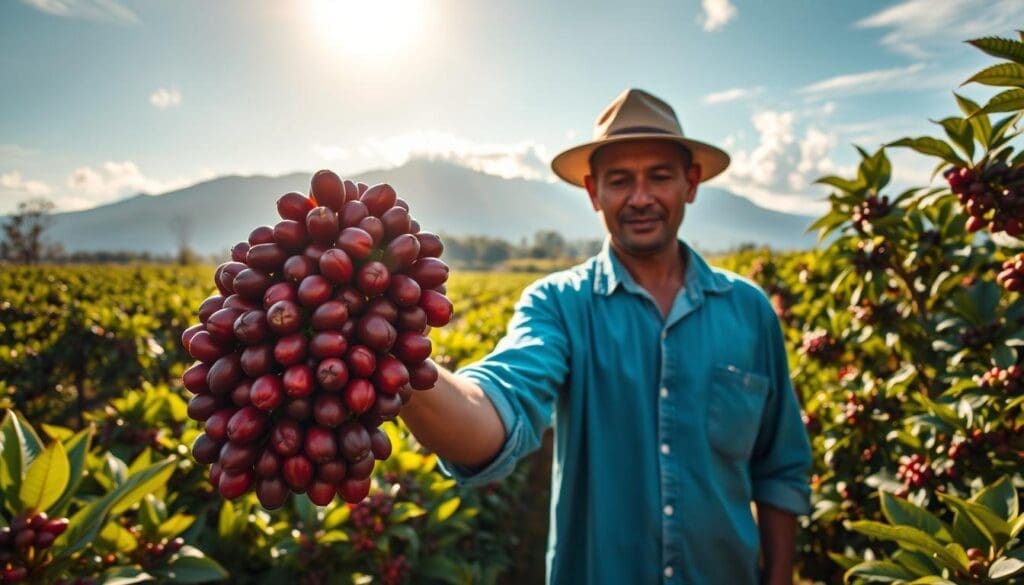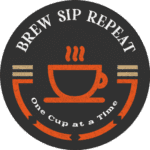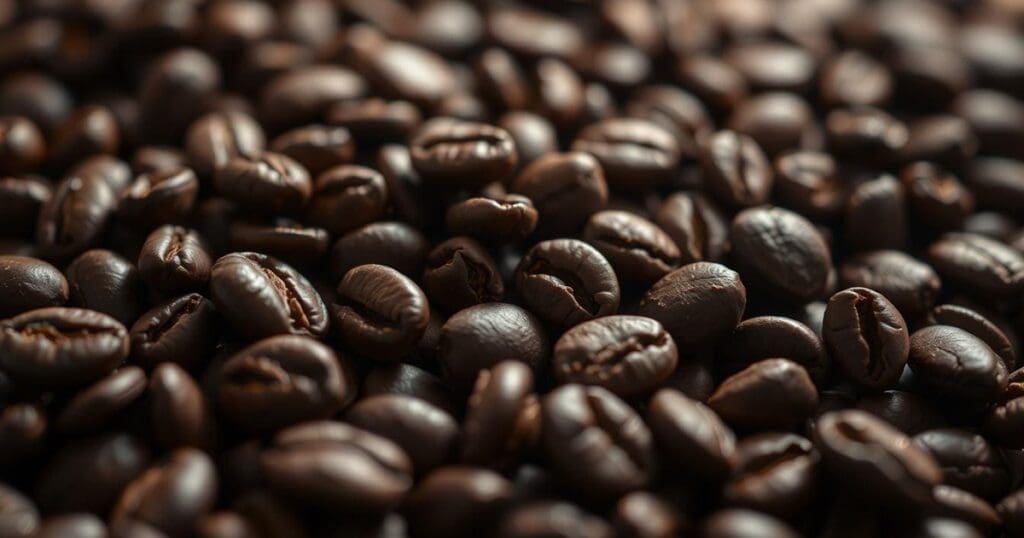Choosing the right coffee beans for cold brew is key to a great flavor. With many options, picking the best can be tough. So, what makes the best coffee beans for cold brew, and how do you pick the right ones?
To get the perfect flavor, consider the bean type, roast level, and grind size. Knowing these factors helps you pick the best coffee beans for your cold brew. Whether you’re a coffee expert or new to cold brew, choosing the right beans is essential for a delicious cup.
Understanding Cold Brew Coffee
Cold brew coffee is made by steeping coffee grounds in cold water for 12-24 hours. This method creates a smooth, low-acidity coffee perfect for summer. Unlike other brewing methods, it doesn’t use heat, which can make coffee taste bitter.
The cold brew vs. hot brew debate often comes down to personal preference. But cold brew coffee has become popular for its smooth taste. It’s also great for those who don’t like acidic coffee.
The cold brew process focuses on the coffee to water ratio. A standard ratio is 1:4, but you can adjust it to taste. For a stronger coffee, use 1:3. For a milder taste, try 1:5. Finding the right balance is key to a great cold brew coffee.
Compared to hot brew, cold brew coffee lasts longer when refrigerated. Its smooth taste makes it a great choice for trying something new.
The Basics of Coffee Beans
Coffee beans are key to a great cup of coffee. There are many types to pick from. Arabica and Robusta are two common ones. Arabica makes up 60-70% of global coffee, while Robusta is 30-40%.
Arabica beans are known for their smooth, mild taste and aroma. Robusta beans, on the other hand, have more caffeine and a stronger, bitter taste. They’re also cheaper and grow in lower altitudes. Your choice between Arabica vs. Robusta depends on what you like.
Knowing about types of coffee beans is important for picking the right ones for cold brew. Whether you like Arabica’s mild flavor or Robusta’s bold taste, understanding each type helps. Trying different coffee beans can be exciting and rewarding.
In conclusion, coffee beans are essential for the taste and quality of your cold brew. By knowing the differences between types of coffee beans and their unique qualities, you’ll be on your way to making the perfect cold brew coffee.
Flavor Profiles for Cold Brew
Cold brew coffee is known for its unique flavor profiles. These can change based on the coffee bean type. The flavor is often smooth and low in acidity, perfect for those who like a milder taste.
When it comes to coffee flavor notes, cold brew offers a wide range. You can find flavors from bright and fruity to smooth and chocolaty.
The type of coffee bean used greatly impacts the flavor. Lighter roasts have brighter, fruitier flavors. Darker roasts are smoother, with chocolaty notes. Medium to dark roasts are often chosen for cold brew because their flavors stand out even when diluted.

Trying different coffee beans and roast levels can help you find your perfect cold brew flavor. Ethiopian Yirgacheffe is known for its floral and citrus notes. Colombian Supremo is prized for its sweet and nutty flavors. By exploring these options, you can create a unique coffee drink that matches your taste.
Whether you like bright and fruity or smooth and chocolaty flavors, cold brew has something for everyone. Its low acidity and smooth taste make it a great choice for coffee lovers. Exploring cold brew’s flavor profiles can lead to new and exciting ways to enjoy your coffee.
Roast Levels Explained
Choosing the right coffee beans for cold brew means knowing about roast levels. Roast levels show how dark coffee beans are roasted. This greatly changes the taste of the coffee. Light roast beans are often more acidic and fruity. In contrast, dark roast beans are richer and more full-bodied.
Coffee beans can be roasted to many levels, including medium roast. This level offers a balanced taste. The roast level affects the cold brew’s taste. Dark roast beans make the flavor bolder and more intense. Light roast beans give a brighter, more acidic taste.
For cold brew, medium roast and dark roast beans are often chosen for their richer flavors. But, the choice depends on what you like. Some like the bright, acidic taste of light roast. Others prefer the bold taste of dark roast.
Knowing about roast levels and their impact on taste helps in choosing coffee beans for cold brew. This way, you can make your cold brew match your taste. Whether you prefer a bright light roast or a rich dark roast, you can find the perfect one.
Grinding Your Coffee Beans
The grind size of your coffee beans is key to the taste of cold brew. It should be coarse, like sea salt or raw sugar. This grind is larger than what’s used for French press, ensuring the right flavor balance in your cold brew.
A burr grinder is the best choice for grinding your coffee. It gives a consistent grind. Blade grinders, on the other hand, can heat up the beans, ruining the flavor. The right grind size is important for the extraction rate, and a coarse grind is best for cold brew.
The grind size affects the cold brew’s taste. Coarser grinds make it smoother, while finer grinds make it bitter. Use a burr grinder to get a coarse grind. This ensures your cold brew is balanced and refreshing.
Try different grind sizes to find the perfect one for your cold brew. Start with a coarse grind, like sea salt or raw sugar. Adjust as needed. Finding the right grind size will make your cold brew delicious and refreshing, any time of day.
Sourcing Quality Beans
There are many ways to find coffee beans. Buying from a trusted supplier is key for quality. Intercontinental Coffee Trading offers top-notch, whole green coffee beans for cold brew and more. This ensures the beans are fresh and of high quality.
Looking to buy coffee beans? It’s important to find a supplier known for quality. Read reviews, ask for advice, and check their reputation. Quality beans are vital for the perfect flavor, and a good supplier makes a big difference.

Identifying quality beans involves looking at origin, processing, and roast level. Arabica beans have a mild flavor, while Robusta is bolder and more bitter. Knowing these details helps coffee lovers choose the right beans.
Finding the best coffee beans is essential for great cold brew. Research, read reviews, and check the supplier’s reputation. Whether online or in-store, focus on quality and freshness for the best coffee experience.
Freshness is Key
Coffee bean freshness is key to the flavor of cold brew coffee. The freshness of coffee beans greatly affects the taste and quality of the brew. It’s important to know how fresh your coffee beans should be and how to store them.
For coffee bean freshness, the fresher the beans, the better the flavor. Storing coffee beans in an airtight container in the fridge keeps them fresh. This prevents air, moisture, and other elements from affecting the beans and changing their flavor.
It’s best to use coffee beans within a few days of opening. The first source says, “your brew will taste its freshest in the first few days.” Coffee beans lose flavor and aroma quickly after roasting and grinding. Using fresh coffee beans and storing them right ensures your cold brew coffee tastes its best.
Proper storing coffee beans is key to keeping them fresh. Keep them in an airtight container, away from sunlight and heat. By following these tips, you can preserve the flavor and aroma of your coffee beans. This makes your cold brew coffee taste better. The importance of coffee bean freshness is huge, as it directly affects your brew’s quality.
Experimenting with Blends
Cold brew coffee fans often enjoy experimenting with blends. Mixing different coffee beans can create unique flavors. Both single-origin coffees and coffee blends can make great cold brew, depending on what you like.
When experimenting with blends, think about the flavors of each coffee bean. Brazilian beans have chocolatey and nutty tastes. Sumatran beans are earthy. Mixing these can make a cold brew that’s both rich and full-bodied.
Popular coffee blends for cold brew mix beans from various places. These blends offer balanced flavors with chocolate, nuts, and fruit notes. As people keep experimenting with blends, they might find new, exciting flavors for their cold brew.
The art of experimenting with blends lets coffee lovers explore new cold brew possibilities. By mixing different beans and flavors, they can make cold brews that match their taste preferences.
Regional Coffee Varieties
The origin of cold brew coffee beans greatly affects its taste. Regional coffee varieties bring a wide range of flavors. Ethiopian Yirgacheffe is bright and fruity, while Sumatra Mandheling is earthy and spicy.
Coffee lovers often choose single-origin coffee for its unique taste. This taste comes from the region’s climate, soil, and how the beans are processed. Places like Colombia, Brazil, and Kenya are famous for their quality beans.

Peru is known for its mild and balanced flavor, perfect for cold brew. Indonesia offers a robust taste with earthy notes. Whether you like a light or full-bodied brew, there’s a regional coffee variety for you.
Exploring different regional coffee varieties and single-origin coffee can open up new flavors. It can make your cold brew even better. So, start your journey to find the perfect cold brew for you.
The Importance of Water Quality
Coffee is mostly water, up to 98%. This shows how important water quality is for taste. Optimal water temperature and brewing water quality are key to getting the best flavor from coffee beans.
Several factors affect water quality. The best Total Dissolved Solids (TDS) level for coffee is about 150 ppm. Water should have 70 to 100 milligrams per liter of calcium carbonate for the best taste. The pH level should be close to neutral (7) to avoid sour or soapy tastes.
Water with a slightly higher TDS can make cold brew coffee taste richer. But, chlorine in tap water can make coffee taste like a swimming pool. It’s important to descale coffee equipment every couple of months to keep it working well.
How Water Affects Flavor
The natural acidity of coffee, between 4.85 and 5.10 pH, can change with water quality. Optimal water temperature and quality help balance acidity and bring out flavors.
Ideal Brewing Water for Cold Brew
For cold brew coffee, use water without impurities and with the right minerals. Systems like the Bluewater Café Station™ can purify water up to 99.7%. This removes impurities and lets you adjust mineral levels for a better coffee experience.
Brewing Techniques to Consider
When making cold brew coffee, the brewing techniques matter a lot. The equipment you use, like a cold brew kit or Mason jar, can change the taste. It’s important to try different methods to find the best one.
The brewing time also plays a big role. Longer times make the coffee stronger and more full-bodied. Shorter times result in a lighter, refreshing taste. Knowing how brewing time affects flavor is key to making the perfect cold brew.
Cold Brew Methods and Brewing Time
There are many cold brew methods, each with its own needs. The ideal brew ratio is 1:8, and the grind should be medium-coarse. Brewing time usually ranges from 12-24 hours. By trying different methods and times, you can find the perfect flavor and strength.
Choosing the right brewing techniques and methods can greatly improve your coffee’s quality. By understanding how brewing time and equipment affect flavor, you can make a better cold brew. The trick is to experiment and find the perfect mix for your taste.
Putting It All Together
Now that you’ve learned about choosing the perfect coffee beans for cold brew, it’s time to put it all together. The perfect cold brew needs a balance of factors. This includes the beans’ origin and roast level, the brewing method, and the water quality.
When picking beans for your cold brew, go for medium to dark roasts. They bring out the rich, chocolatey and nutty flavors that cold brew loves. Try single-origin beans or unique blends to find new flavors.
Remember, freshness is key. Choose whole bean coffee and grind it just before brewing. This ensures the best aroma and taste. Play with different grind sizes and brew times to find what you like best.
By following these cold brew tips, you’ll be on your way to making the ultimate cold brew experience at home. Enjoy the smooth, refreshing, and flavorful coffee you’ve carefully chosen.




Facebook Comments